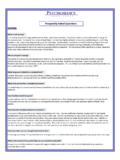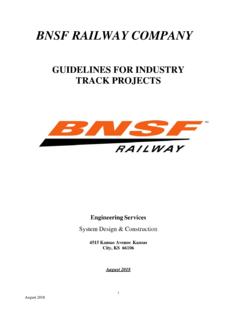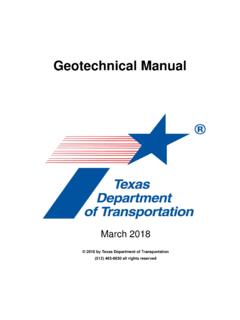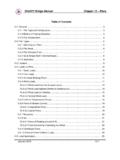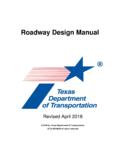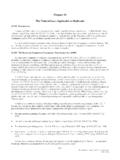Transcription of BNSF RAILWAY COMPANY
1 August 2018 1 bnsf RAILWAY COMPANY GUIDELINES FOR INDUSTRY TRACK PROJECTS Engineering Services System Design & Construction 4515 Kansas Avenue Kansas City, KS 66106 August 2018 August 2018 2 bnsf RAILWAY COMPANY Design Guidelines for Industry Track Projects August 2018 Table of Contents Page 1. General Procedure for Industrial Track Projects 4 2. Standards for Industrial Trackage (Non-Unit) 6 3. Standards for Unit Train/Loop Facilities 10 4. Survey and Plan Requirements 14 5. Specifications for Construction of Industrial Trackage by Private Contractor 20 6. Track Inspection Acceptance Checklist 28 7. Requirements for Working on bnsf Right of Way 29 Appendix List Page Procedures for Continuous Welded Rail in Industry Tracks A-1 9 Preliminary Conceptual Sketch Example A-10 Standard Sections for Industry Track A-11 13 Construction Pad Details Manual Turnouts A-14 Earthen Bumper Details A-15 No.
2 9 Turnout Plan and Geometry A-16 21 No. 11 Turnout Plan and Geometry A-22 27 No. 15 Turnout Plan and Geometry A-28 33 Double Switch Point Derail (16'-6") A-34 Switch Stand with 30 Degree Handle and Target A-35 - 36 August 2018 3 Appendix List (cont.) Page Road Crossings A-37 39 Clearance Requirements and Sign A-40 42 Vertical Curves A-43 44 Underground Cable Locate Form A-45 Point of Switch and Derail Stake-out Guidelines A-46 Receipt of Design Guidelines A-47 August 2018 4 1. General Procedure for Industrial Track Projects The purpose of this chapter is to guide the process for the development of industry tracks and facilities. Build-ins and tracks other than industrial need to follow bnsf s Main Line Design Guidelines for Track Projects. Customer will contact bnsf s Economic Development (ED) representative. Contact information and a questionnaire can be found at After completing the questionnaire the customer will be asked to provide a conceptual layout for the project.
3 This layout should include property boundaries, existing buildings and roads, and a general location of where the proposed tracks will be located. bnsf will consider the feasibility of constructing the project at the desired location along with operating issues related to product origins and destinations. bnsf will prepare a scaled track layout (project schematic) based on the customer s concept to ensure the desired operation meets design standards. The project schematic will identify both bnsf s and the customer s scopes of work, and then be shared with the Customer (see appendix, page A-10 for an example). After bnsf approval of the opportunity (New Business Review) the customer will be provided a cost estimate for bnsf s track and signal work. The Customer may use a designer or contractor of its choice to prepare the track plans. Survey on bnsf right-of-way will require the application of a temporary occupancy permit (see Requirements for Working on bnsf Right of Way ).
4 The project schematic should be used as a guide for preparing the industrial track plan. Plans should be complete with all the items in the Final Track Plan Checklist included. Questions concerning these guidelines should be directed to the bnsf Engineering representative. Customers are encouraged to reference this document, including standard plan drawings, in the construction specifications. bnsf Engineering will review and approve the track design, and if there are significant changes from the original project schematic, the plan may need to be reviewed by other bnsf departments. bnsf Engineering will communicate directly with the Customer regarding any plan revisions. Any revisions will be documented on the prints and communicated in writing to the Customer. bnsf Engineering will notify ED when the industrial track plan has been reviewed and approved. bnsf Engineering will prepare a cost estimate, chargeable to the Customer, which includes bnsf s portion of track and signal construction, as well as an appropriated amount for an Inspector/Coordinator for construction monitoring purposes.
5 The cost estimate does not include flagging charges as they can vary significantly based on the approach adopted by the customer s contractor. In general, bnsf will construct from point of switch to the 14-ft clearance point for manual switches, and from the point of switch to just beyond the power derail and the approach signal for powered switches. The Inspector/Coordinator will serve as a bnsf representative related to grading on bnsf R/W, utility drops, turnout installation schedules and customer track construction inspection. Upon receiving the Firm Bid Cost Estimate, ED will present the formal industrial track package, including all agreements and cost proposal, to the Customer for consideration. Upon Customer's acceptance of the proposal (check, fully executed agreements, and submittal of the final plans) ED will notify all concerned the project has been approved and funded.
6 The final plans must be approved by bnsf Engineering prior to the execution of the contractor s right of entry, which limits when work can start on bnsf property. Materials for bnsf s portion of the project are then ordered, work scheduled and construction completed, which can take up to 27 weeks. Customers should note that turnout construction pads must be completed 6 weeks or more August 2018 5 (dependent on territorial restrictions) before the target construction completion timeline to allow time to deliver, assemble, and install the turnout at the designed location. Following is the timeline for a typical industry track project STAGE ACTIVITY START END TIMELINE 1 New opportunity conceptual layout request Conceptual layout request received Conceptual layout delivered to ED Mgr. 1 week 2 New Business Review (internal bnsf assessment) NBR created NBR completed 2 weeks 3 Project schematic approval & cost estimate preparation NBR completed notification bnsf cost estimates completed 9 weeks 4 Customer acceptance & payment Proposal letter sent Check deposited 9 weeks 5 Request for capital Check deposited / CPAR approved AFE approved 3 weeks 6 Track & signal materials ordered and delivered AFE approved Track and signal material delivered 13 weeks 7 Track & signal construction Customer agreements & contracts executed Track and signal construction complete 13 weeks 8 Engineering & Construction complete Final customer track inspection completed Actual project in service date entered in ESI 1 week 9 Customer moves cars into facility Project Closeout Actual project in service date entered in ESI CDI, CRF & Credit complete 1 week Total Engineering and Construction timeline 52 weeks August 2018 6 2.
7 Standards for Industrial Trackage (Carload, or Non-Unit Facilities) Roadbed: Roadbed and ballast section for industrial trackage shall conform to the special roadbed section (see appendix, page A-11), and to the ballast material requirements on page 24. Curvature: Maximum degree of curve shall not exceed 9 30' ( ' radius). All curves are defined using the chord definition. A minimum tangent length of 50 feet must be placed between reversing curves. No turnouts (switches) can be placed in a curve. Mainline turnouts must be placed at least 200 feet from the end of a mainline curve. Industry turnouts within the facility must be placed at least 50 feet from the end of any curve. Profile Grade: Track profile grades shall be limited to a maximum of Vertical Curves: Vertical curves must be provided at break points in profile grade. The rate of change shall not exceed in summits or sags. Vertical curves shall not extend into limits of turnout switch ties.
8 See appendix, pages A-43 and A-44 for bnsf 's standard for vertical curves. Track: Recommended rail section is 115-lb. or greater. Hardwood ties shall be new 7 X 8 (No. 4) or 7 X 9 (No. 5), 8 -6 long, placed on " centers with a 6 ballast section. Rail anchorage shall be provided at a minimum rate of 16 anchors per 39' panel. Continuous welded rail (CWR) shall be box-anchored every other tie. Concrete ties can be spaced at 28 center to center with an 8 ballast section. CWR is recommended when using concrete ties. M-8 steel ties (8mm or 5/16 section) can be used in non-unit facility tracks and are spaced at 24 centers with 8 ballast section. Turnouts: All main line, controlled siding and passing track turnouts will be a minimum new No. 11-141 lb. and include either a spring-rail frog or a rigid, railbound manganese frog, as specified by bnsf Engineering. For other turnouts maintained by bnsf , the size and weight will be determined dependent upon the transportation commodity, with a No.
9 11-141 lb. recommended, and a No. 9 - 115 lb. as the minimum (see appendix, pages A-16 to A-33). Main line turnout switch ties shall be new and hardwood. All mainline, controlled siding and passing track turnouts and trackage are to be placed by bnsf personnel out to the 14' clearance point. Mainline, controlled siding and passing track turnouts will require the placement of a construction pad alongside the track to allow assembly of the turnout, with no disruption to traffic. After the turnout is assembled, a track window is obtained to remove the trackage and insert the turnout. An example of a construction pad is shown in the appendix on page A-14. For turnouts placed off of bnsf property and/or maintained by the Customer, and operated by bnsf , the recommended minimum is a No. 9 - 115 lb. All switch stands need to include a "30 Degree" handle (see appendix, page A-35), and a target with alternating green and yellow colors indicating switch position (page A-36).
10 Switch heaters are required for mainline turnouts where snow and ice present operational challenges. If a power turnout requires a switch heater, the power derail will require one also. The cost estimate will include installation of the switch heaters when required. Derails: A derail shall be placed on all tracks connecting with a main line, siding, or industrial lead. Derails protecting mainline tracks and controlled sidings shall be double switch point (see appendix, page A-34) and installed so that the derailed car is directed away from bnsf trackage. A power derail is required when the mainline turnout is powered, and bnsf will install track and signal from the point of switch to the insulated joints just beyond the power derail. Derails protecting mainline tracks shall be placed a minimum of 100 feet behind the 14' clearance point, and placed on tangent track where possible. Derails protecting other-than-mainline tracks shall be placed a minimum of 50 feet behind the 14' clearance point, and placed on tangent track where possible.



